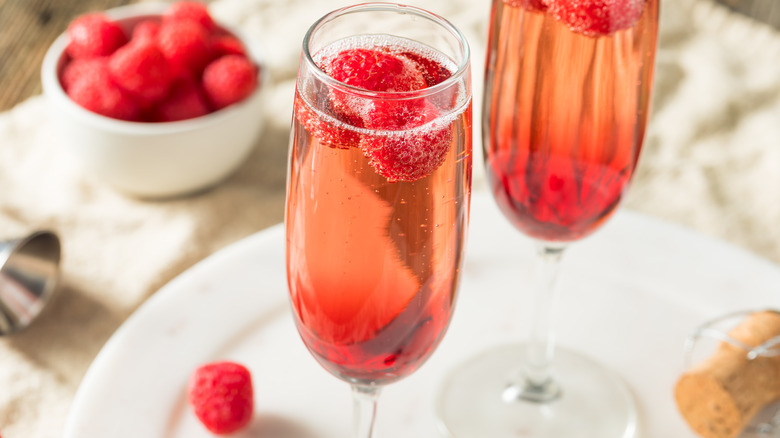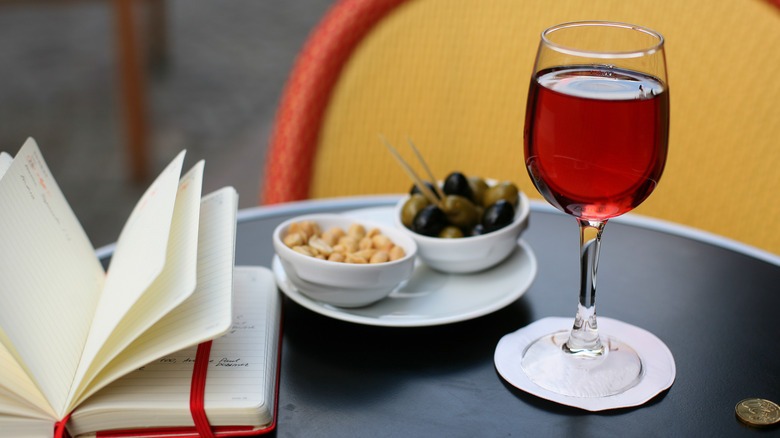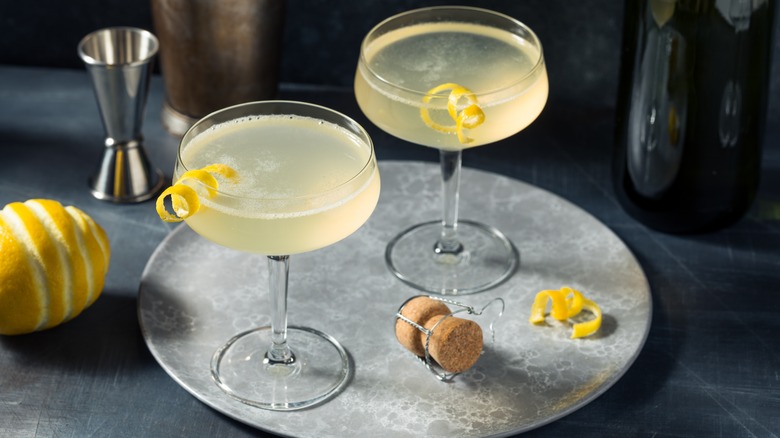The Desperate Wartime Origins Of The Kir Royale Cocktail
The Kir Royale is a simple yet sophisticated cocktail that originates from the Kir, which is a mixture of one part crème de cassis liqueur (blackcurrant liqueur) to four parts dry white wine. To elevate it to a Royale, you simply substitute champagne for the wine. The bubbly, fruity nature of the drink makes it a popular choice for special occasions like birthdays, weddings, and Bastille Day, yet this glamorous cocktail has a somewhat gritty origin.
The Kir was created by a French Catholic priest named Felix Kir, who was also a key figure in the French resistance against the Nazis during World War II. While others fled the war-torn country, Kir remained, and ultimately helped free more than 4,000 prisoners of war in the Burgundy region of France. Although it's challenging to verify the story in its entirety, it's widely believed that when the Nazis confiscated the celebrated red wine from Burgundy, Kir innovated a substitution as an act of defiance.
He used a white wine that was still available, called Aligoté, and added crème de cassis to mimic the color of Burgundy red wine. Despite the horrific acts committed by the brutal Nazi regime, this small act of resistance undoubtedly helped lift the community's spirit.
The Kir became synonymous with Dijon, France
When the war ended, both the Kir and its more celebratory variant, the Kir Royale, lived on, as did their creator. Felix Kir was honored with France's Legion d'honneur (the equivalent of the American Purple Heart Medal) for his rescue efforts, and was elected mayor of Dijon, the capital of Burgundy, a position he held from 1945 until his death in 1968. He reportedly served the cocktail to visiting dignitaries during his tenure, and according to the Wall Street Journal, he is said to have called the Kir "the official beverage of Dijon's city hall."
While it's uncertain if Kir was the first to substitute champagne for white wine, creating the Kir Royale, such an innovation seems fitting for post-war celebrations. As simple as they are, the Kir and the Kir Royale are successful, flavor-wise, because they pair the sweetness of crème de cassis — which is also an ingredient that makes plums taste fruitier — with the sharp acidity of Aligoté and brut champagne, creating a beautiful balance. In France, Kirs are commonly enjoyed as aperitifs, while Kir Royales are typically reserved for more significant occasions since they are more expensive to make.
With wartime comes cocktails
Not surprisingly, several classic cocktails emerged during times of war. The French 75 was supposedly created by French-American fighter pilot Raoul Lufbery during World War I. The self-professed champagne drinker desired something more potent one day, and spiked his coupe with cognac. Afterwards, he claimed to feel as though he'd been hit by a piece of a French 75mm cannon, thus naming the drink. During the same war, the brandy-based sidecar was born. It's believed that a United States Army captain, who regularly rode in the sidecar of a motorcycle, stopped by a Parisian bar feeling under the weather. The bartender concocted a tonic of brandy, orange liqueur, and lemon juice to aid the ailing soldier's recovery.
Since its inception during World War II, the Kir and the Kir Royale have largely remained unchanged, though some have experimented with the drink's flavors by substituting raspberry or peach liqueur for the blackcurrant one. Other variations include a Cider Royale, which uses hard cider instead of champagne, and a cardinal, made with red wine and crème de cassis.



